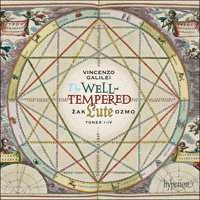Texte paru dans: / Appeared in: |
|
|
Outil de traduction ~ (Très approximatif) |
|
|
Reviewer:
Barry Brenesal Vincenzo Galilei (c. 1520–1591) was by all accounts one of the best lutenists in Count Bardi’s tempestuous Florentine Camerata, as well as one of its most ardent theorists and strongest polemicists. (He had a nasty habit of publishing play-like satirical essays in which he put his opponents’ arguments in the mouths of fools, while turning them into strawmen by deliberately distorting the points they made. This trait was picked up, unfortunately, by his son Galileo, who paid for it as his father never did.) Although the envy and jealousy among the Camerata’s members led to incessant turf wars—as did their hatred for a rival group led and financially supported by Jacopo Corsi—they were unified behind two ideas. First, the music of the day was insipid, inexpressive, formally turgid, and had lost its purpose. Second, the Attic Greeks had musical structures and content that was both more pure and ideally expressive. While it’s accepted today that the Camerata’s idea of Greek music was based on several flawed concepts (they thought, for example, that Greek tragedies were through-composed and sung), their attempt to resurrect what they thought the Greeks had done resulted in a number of startling and sometimes successful developments that would greatly affect the future course of classical music. Thus, they opposed the inflexible, often pedantic rules of Gioseffo Zarlino regarding dissonance, and developed a form of theatrical entertainment in which the emotion projected by the performer was enhanced by simple, expressive music—the first operas. Galilei in particular was concerned with modes and tuning systems. He argued relentlessly that modern church modes were not identical to Attic Greek ones, and that the modes currently in use could not have been those referred to in writing by Greek and Latin theorists of a far earlier time. In his Libro d’intavolature di lituo of 1584, along with other issues, he took a stand in favor of an equal temperament tuning system that would allow one to transpose works among all 12 degrees of the scale with identical results. To this end, he used the Dorian and Ionian modes, which most closely resemble the modern (then, and now) concept of major and minor tonality, and applied them to three dance types: the passamezzo, romanesca, and saltarello, employing a series of near-identical harmonic patterns. Žak Ozmo has chosen to record the works in both modes for the first four tones. He’s arranged them into suites with an almost schematic effect, each Dorian passamezzo and romanesca followed by a corresponding saltarello, and then the Ionian passamezzo and romanesca for that tone. Ozmo writes in his detailed liner notes of doubts among lutenists and scholars as to whether the pieces in this collection where ever meant to be performed, due to their exceptional difficulty. He describes the problems well, but I find myself wondering if, in addition to their issues of intricacy and positioning, the value of these pieces as music-for-listening form a second, equally strong argument against their performance as a unit. Put simply, the deliberately, endlessly repeating harmonic patterns between pieces of a kind in successive tones makes for sameness. So does the bland thematic content, which frequently pursues identical figurations. Of the four Ionian romanesche moderna included on this album, for example, those listed as book 2/2, 2/4, and 2/6 all start out very much alike. Nor do they have much musical character, but seem to slot in and out of specific, repetitive musical formulae at various points—perhaps because Galilei wanted to demonstrate how much alike the same figurations would sound to the ear when placed anywhere among his 12 degrees. Only the fourth romanesca moderna, book 2/8, abandons the incessant, indistinguishable figures for a theme around which the figures assume the character of divisions. Much the same can be said of the other dance forms Galilei uses in this work, always with the puzzling exception of tone IV, whose five pieces offer a bit more musical distinction than their equivalents in the first three tones. Ozmo to his credit tries varying tempo and adding a range of dynamics and accenting as a means to achieve greater diversity. He performs this difficult music extremely well and articulates cleanly. None of this can help the relatively low level of listening value among most of these pieces, however. The engineering doesn’t quite help, either, being a bit dull on the treble end. But even if you use an equalizer to improve the result, you’re still left with a lot of works intended to prove a point, which don’t make for attractive, distinctive music. Up to you. | |
|
|
|
|
Cliquez l'un ou l'autre
bouton pour découvrir bien d'autres critiques de CD |
|




